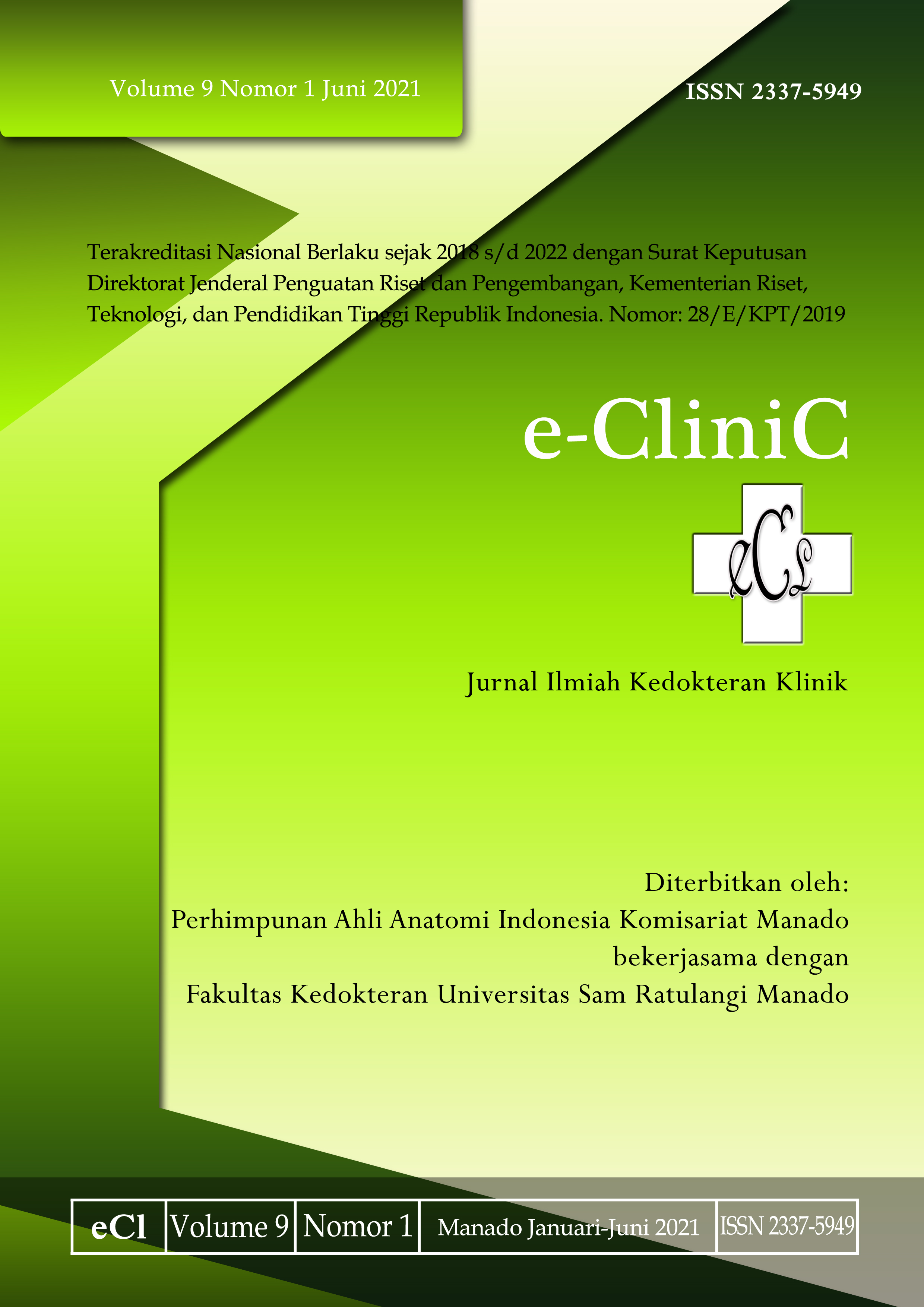Gambaran Luaran Fungsional Tatalaksana Pasien Neglected Fraktur Sub-trokanter Menggunakan Reversed Distal Femur Limited Contact Dynamic Compression Plate di Rumah Sakit Bhayangkara Manado
DOI:
https://doi.org/10.35790/ecl.v9i1.32305Abstract
Abstract: Â Subtrochanter fracture is still a health problem due to the difficulty of treatment and the high incidence of non-union and malunion after treatment. Limited Contact-Dynamic Compression Plate (LC-DCP), an implant designed to be used in distal femur fractures, is reported as an alternative for the treatment of subtrochanter fractures. This study was aimed to obtain the functional outcome of neglected subtrochanter fractures using reversed distal femur LC-DCP at Bhayangkara Hospital Manado. This was a retrospectoive study using the medical record and by-phone evaluation of patients with neglected subtrochanter that were managed with the reversed distal femur LC-DCP in 2018-2019 at Bhayangkara Hospital, Manado. Patients were evaluated with the Harris Hip Score (HHS). The results showed that there were 6 patients who met the inclusion criteria and could be contacted by phone. The HHS results showed 6 patients of poor category (mean score of 25.6) at 3 months after surgery; 3 patients of poor category and 3 patients of fair category (mean score of 66.4) at 6 months after surgery; and 4 patients of good category and 2 patients of excellent category (mean score of 89.9) at 12 months after surgery. In conclusion, the functional outcomes of the patients were poor category at 3 months after surgery, poor to fair at 6 months after surgery, and good to excellent at 12 months after surgery.
Keywords: functional outcome, neglected subtrochanter fracture, reversed distal femur limited contact – dynamic compression plate, Harris hip score
Â
Abstrak: Fraktur subtrokanter masih merupakan masalah kesehatan karena sulitnya penanganan dan tingginya angka kejadian non-union dan malunion setelah penanganan. Limited contact-dynamic compression plate (LC-DCP) yaitu implan yang dirancang untuk fraktur femur bagian distal dilaporkan dapat dijadikan alternatif untuk penanganan fraktur subtrokanter. Penelitian ini bertujuan untuk memperoleh gambaran luaran fungsional tatalaksana pasien neglected fraktur subtrokanter menggunakan reversed distal femur LC-DCP di RS Bhayangkara Manado. Jenis penelitian ialah retrospektif menggunakan data rekam medis dan evaluasi melalui telepon pada pasien dengan neglected fraktur subtrokanter yang ditatalaksana menggunakan reversed distal femur LC-DCP pada tahun 2018-2019 di RS Bhayangkara Manado. Pasien dievaluasi dengan Harris Hip Score (HHS). Hasil penelitian mendapatkan 6 pasien yang memenuhi kriteria inklusi. Hasil evaluasi HHS mendapatkan 6 pasien kategori poor (rerata skor 25,6) saat 3 bulan pasca operasi; 3 pasien kategori poor dan 3 pasien fair (rerata skor 66,4) saat 6 bulan pasca operasi dengan; dan 4 pasien kategori good dan 2 pasien dengan kategori excellent (rerata skor 89,9) saat 12 bulan pasca operasi. Simpulan penelitian ini ialah luaran fungsional pasien-pasien tersebut ialah HHS poor pada 3 bulan pasca operasi; HHS poor-fair 6 bulan pasca operasi; dan HHS good-excellent pada 12 bulan pasca operasi.    Â
Kata kunci: luaran fungsional, neglected fraktur subtrokanter, reversed distal femur limited contact – dynamic compression plate, Harris hip scoreDownloads
How to Cite
Issue
Section
License
COPYRIGHT
Authors who publish with this journal agree to the following terms:
Authors hold their copyright and grant this journal the privilege of first publication, with the work simultaneously licensed under a Creative Commons Attribution License that permits others to impart the work with an acknowledgment of the work's origin and initial publication by this journal.
Authors can enter into separate or additional contractual arrangements for the non-exclusive distribution of the journal's published version of the work (for example, post it to an institutional repository or publish it in a book), with an acknowledgment of its underlying publication in this journal.
Authors are permitted and encouraged to post their work online (for example, in institutional repositories or on their website) as it can lead to productive exchanges, as well as earlier and greater citation of the published work (See The Effect of Open Access).







